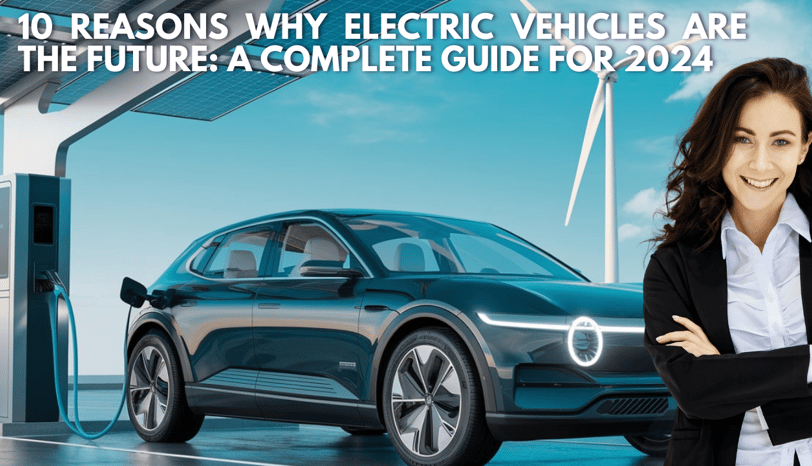10 Reasons Why Electric Vehicles are the Future: A Complete Guide for 2025.
A modern electric vehicle charging at a solar-powered station, set against a backdrop of wind turbines and solar panels. This futuristic illustration highlights the synergy between EVs and renewable energy, symbolizing a clean, sustainable future in transportation."
BLOG POST
evnovatech.com
12/22/20244 min read


10 Reasons Why Electric Vehicles are the Future: A Complete Guide for 2025.
Introduction
The EV revolution is here, and it’s unstoppable! As the world accelerates toward a cleaner, greener future, electric vehicles (EVs) have emerged as a game-changing innovation. With governments and automakers pledging to reduce carbon emissions, EVs are no longer a niche choice—they're rapidly becoming mainstream. But what makes these vehicles so compelling, and why are they hailed as the future of transportation? This guide explores the key reasons behind the surge in EV popularity and what the future holds for this transformative technology.
Section 1: What Are Electric Vehicles?
Definition and History
Electric vehicles (EVs) are cars powered entirely or partially by electricity stored in rechargeable batteries. Unlike traditional internal combustion engine (ICE) vehicles that rely on gasoline or diesel, EVs use electric motors for propulsion.
The concept of EVs dates back to the early 19th century when inventors experimented with electric-powered carriages. However, with the mass production of gas-powered vehicles by Henry Ford in the early 20th century, EVs took a back seat—until recently. Advances in battery technology, environmental awareness, and government incentives have reignited interest, making EVs a viable and attractive option for modern drivers.
Section 2: Advantages of EVs
1. Environmental Benefits
EVs produce zero tailpipe emissions, making them a critical tool in combating air pollution and reducing greenhouse gas emissions. By transitioning to EVs, cities worldwide can enjoy cleaner air and a healthier population.
2. Financial Savings
Although EVs can have higher upfront costs, they offer long-term savings. Electricity is cheaper than gasoline, and EVs require less maintenance due to fewer moving parts. Over time, drivers can save thousands of dollars in fuel and repair costs.
3. Energy Efficiency
EVs are inherently more efficient than ICE vehicles. While traditional cars waste energy through heat and friction, EVs convert a higher percentage of energy from the grid into motion, reducing overall energy consumption.
4. Quiet and Smooth Ride
Without noisy engines or gear shifts, EVs offer a quieter, smoother driving experience. This makes them ideal for city commutes and long-distance travel alike.
5. Technological Innovation
Modern EVs come equipped with cutting-edge features such as autonomous driving capabilities, over-the-air software updates, and advanced driver assistance systems (ADAS). These technologies enhance safety and convenience, setting EVs apart from their ICE counterparts.
Section 3: Challenges of EV Adoption
1. Charging Infrastructure
One of the biggest hurdles is the availability of charging stations. While urban areas are rapidly expanding their charging networks, rural regions still face limited access. Governments and private companies are working to bridge this gap, but widespread adoption will take time.
2. Upfront Costs
Despite falling battery prices, EVs remain pricier than traditional cars. However, as production scales up and technology advances, the cost disparity is expected to diminish.
3. Range Anxiety
Some potential buyers worry about running out of charge during trips. Although many modern EVs offer ranges exceeding 300 miles, this concern persists among drivers unfamiliar with charging options.
4. Recycling and Sustainability
The production and disposal of EV batteries raise environmental concerns. Innovations in battery recycling and sustainable materials are essential to mitigate these issues and ensure EVs remain a green solution.
Section 4: The Future of EVs
1. Next-Gen Batteries
Solid-state batteries promise to revolutionize EVs with higher energy density, faster charging times, and improved safety. As these technologies mature, EV performance will skyrocket.
2. Autonomous Driving
Many EVs are leading the charge in self-driving technology. Companies like Tesla, Waymo, and Rivian are pioneering advancements that could make autonomous vehicles a reality within the next decade.
3. Expanding Markets
Emerging economies are joining the EV revolution, with countries like India, Brazil, and South Africa investing heavily in EV infrastructure and manufacturing. This global expansion will make EVs accessible to millions more people.
4. Renewable Integration
Future EVs will increasingly rely on renewable energy sources such as solar and wind for charging. Coupled with smart grid technology, this will create a cleaner and more efficient energy ecosystem.
5. Policy and Incentives
Governments worldwide are mandating stricter emissions standards and offering incentives for EV buyers, accelerating the shift away from fossil fuels.
FAQs
1. What are the different types of EVs?
There are three main types:
Battery Electric Vehicles (BEVs): Fully electric, no gas engine.
Plug-In Hybrid Electric Vehicles (PHEVs): Combine an electric motor with a gas engine for extended range.
Hybrid Electric Vehicles (HEVs): Use a gas engine with an electric motor but cannot be charged externally.
2. How long do EV batteries last?
Most EV batteries are designed to last 8-10 years or 100,000-150,000 miles. Many manufacturers offer warranties covering this period.
3. Are EVs expensive to maintain?
No. EVs have fewer moving parts and no oil changes, making them cheaper to maintain compared to ICE vehicles.
4. Can I install a charging station at home?
Yes. Home charging stations are increasingly common and can be installed by a certified electrician. Some governments even offer subsidies for installation.
5. Is government support available for EV purchases?
Many countries provide tax credits, rebates, and other incentives to encourage EV adoption. Check with local authorities for specific programs.
6. Do EVs perform well in cold climates?
While extreme cold can reduce battery efficiency, advancements in thermal management systems are minimizing this issue, ensuring reliable performance in all climates.
Conclusion
The rise of electric vehicles marks a pivotal shift in transportation, promising a cleaner, more efficient future. With numerous environmental, financial, and technological benefits, EVs are set to transform the way we drive. While challenges like infrastructure and cost remain, innovations and policy support are paving the way for widespread adoption. By choosing an EV today, you're not just investing in a car—you're contributing to a sustainable planet for generations to come.
